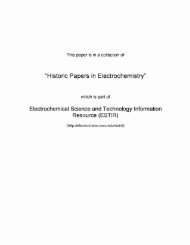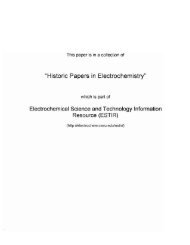The theory of membrane equilibria
The theory of membrane equilibria
The theory of membrane equilibria
You also want an ePaper? Increase the reach of your titles
YUMPU automatically turns print PDFs into web optimized ePapers that Google loves.
THE THEORY OF MEMBRANE EQUILIBRIA'<br />
F. G. DONNAN<br />
Physical Chemistry Laboratory, University College, London<br />
In 1890 Wilhelm Ostwald (1) drew attention to the pecuIiar<br />
electrical and other effects which must occur in a system in<br />
which two solutions containing electrolytes are separated by<br />
a <strong>membrane</strong> which is freely permeable to most <strong>of</strong> the ions, but<br />
impermeable to at least one <strong>of</strong> them. It is a curious fact that,<br />
the interesting ionic <strong>equilibria</strong> and potential differences which<br />
must occur in such a system, and which provide a very striking<br />
pro<strong>of</strong> <strong>of</strong> the existence <strong>of</strong> ionization in solution, were not more<br />
fully investigated at an early stage in the development <strong>of</strong> the<br />
<strong>theory</strong> <strong>of</strong> Arrhenius.<br />
In 1911 the author in collaboration with Harris (2) noticed<br />
the occurrence <strong>of</strong> these peculiar ionic <strong>equilibria</strong> during the<br />
course <strong>of</strong> an investigation <strong>of</strong> the osmotic pressure <strong>of</strong> aqueous<br />
solutions <strong>of</strong> Congo red. As the equilibrium equations result-<br />
ing from the second law <strong>of</strong> thermodynamics are extremely<br />
simple if we assume that the electrolytes are completely ionized<br />
and that the ions act like ideal solutes, a statement <strong>of</strong> these<br />
approximate equations in a number <strong>of</strong> typical cases was given<br />
by the author (3). <strong>The</strong> exact equations can, however, be<br />
stated only in terms <strong>of</strong> the chemical potentials <strong>of</strong> Willard Gibbs,<br />
or <strong>of</strong> the ion activities or ionic activity-coefficients <strong>of</strong> G. N.<br />
Lewis. Indeed an accurate experimental study <strong>of</strong> the <strong>equilibria</strong><br />
produced by ionically semi-permeable <strong>membrane</strong>s may prove<br />
to be <strong>of</strong> value in the investigation <strong>of</strong> ionic activity coefficients.<br />
It must therefore be understood that, if in the following pages<br />
ionic concentrations and not ionic activities are used, this is<br />
done in order to present a simple, chough only approximate,<br />
An essay prepared in connection with the dedication <strong>of</strong> the Sterling<br />
Chemistry Laboratory.<br />
73





